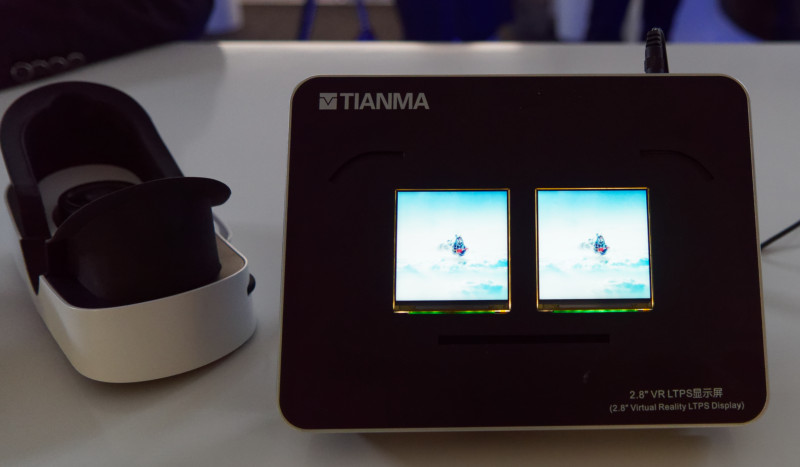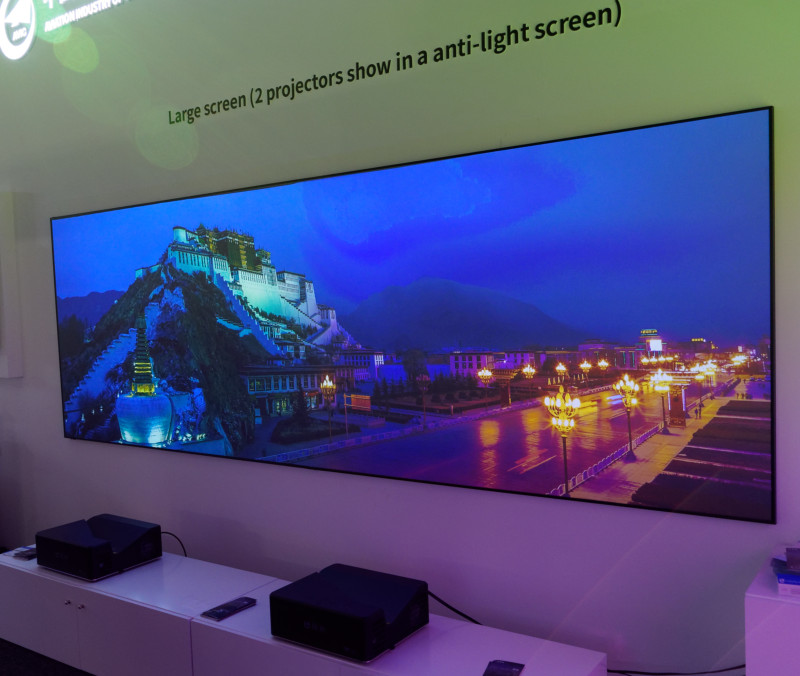AVIC is a major Chinese aviation industry player (the Aviation Industry Corporation of China) and has 100 subsidiaries (‘nearly’ 27 listed companies) and more than 450,000 employees. It had a big booth with companies from the group showing their wares. Most were in software, but we were surprised to get the chance to talk to Tianma, who had some demonstration displays and a couple of staff at the event. It seems that AVIC is a major shareholder in the panel maker, who we normally see at both CES and MWC, although this was not possible this year.
In Laval, Tianma was showing some small displays for VR headsets, a flexible OLED that looked very good and a 27″ transparent display. There were two set-ups for VR. The first was, effectively, a smartphone single LTPS LCD display of 1440 x 2560 resolution and 300 cd/m² of output. The contrast is 750:1 and as the viewing angles were quoted at 80º all around (which is not a big problem in VR as you know where the eyes are going to be!) we assume that the panel is based on TN materials. Response time is quoted at less than 8ms and the panel supports 90Hz operation.
 Tianma’s Flexible OLED looked good. Image:Meko
Tianma’s Flexible OLED looked good. Image:Meko
The second display we looked at closely was a pair of 2.8″ displays, each with 1600 x 1600 resolution and with 450 cd/m² of output and 750:1 contrast. The active area is 50.4 x 50.4 mm, so the panels had fractionally over 800 ppi. The images were very smooth, with little obvious pixellation. We asked if this was the result of any special film being used (3M, for example, has a special film to blur the edges of pixels a little), but we were assured that no special smoothing technology was used – it was just the result of the high ppi count. On the other hand, the optics (which Tianma is not supplying) were fairly crude, so it could just have been a lack of sharpness in the image.
 Tianma’s VR LCDs have just over 800 ppi and looked good. Image:Meko
Tianma’s VR LCDs have just over 800 ppi and looked good. Image:Meko
The 27″ transparent LCD is not a current production item, but Tianma said that it could easily produce it for the right volume. The panel has 2,250 cd/m² of output and 1,600:1 contrast. Transmittance is 18.6% with resolution of 1920 x 1080 and the panel uses an RGBW subpixel structure to enable the higher transmission. The LCD type is Tianma’s SFT technology which is ‘IPS-like’ and the active matrix is based on amorphous silicon. Of course, as a potential supplier of OLEDs, the company is also working on developing transparent OLEDs and may even show a sample at some point this year – we’ll watch out at SID.
 Tianma’s Transparent LCD is very bright. Image:Meko
Tianma’s Transparent LCD is very bright. Image:Meko
Also on the AVIC booth were staff from AVIC GuoHua (Shanghai) Laser Display Technology Ltd and the group had a couple of demonstrations of projection systems. Unfortunately, the staff had limited language skills, so we didn’t get a lot of detail.
There was a demonstration of dual LP40US UST projectors being used together to show a ‘Powerwall’ that can be used by cockpit designers when considering different designs. The images were blended (the lack of sharpness in the blend area was clear, although brightness and colour seemed reasonably well matched). The projector uses a single 0.65mm DLP chip with FullHD and has a throw ratio of 0.25:1 and a fixed lens. Brightness is 4,000 lumens (no particular lumen measurement standard specified) and with 20,000:1 contrast. The system was being shown with an ambient light rejection screen and gave quite a good looking result, although conditions were not easy for projection.
 Avic showed these blended UST projectors. Image:Meko
Avic showed these blended UST projectors. Image:Meko
Also shown was the LP30ES projector (FullHD, DLP, laser phosphor) with a 93″ whiteboard, showing interactivity. Output is 3,200 lumens (again unspeciified).
AVIC GuoHua also has 8,000 and 10,000 lumen 1920 x 1200 units (LP80UL/LP100ULA) with features including ±30% lens shift and a range of different lens options. Features include 3G SDI inputs. The company has products with output of up to 14,000 lumens.

